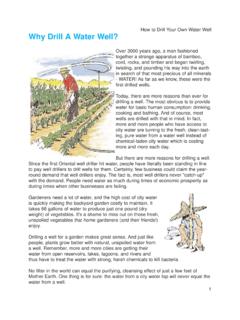Transcription of Building stone steps is different from building a wood ...
1 B uilding a set of stone steps into a yard s hard-to-traverse slope improves a home s curb appeal, and it also makes walking through the yard much more enjoyable. With basic tools and materials, a little patience, and (let s be honest) no small amount of muscle, you can build them yourself. stone steps can be built into any landscape in a relatively short amount of time. The steps featured here took four of us about six hours. Although the process is straightforward, you need to make some decisions and calculations before you start your own stoneAs with any construction project, it s important to have a budget before you begin, but be prepared: stone isn t as cheap as it used to be, unless it comes from your own property. Native, local stone is less costly than stone shipped over state borders, but be mindful of inflated stone StepsSkip the mortar, and use packed quarry dust for a walkway that will last a lifetimeBY CODY MACFIEl ay o u T S T e p S T o a l l o W F o r a c o M F o r Ta B l e S T r I D eBuilding stone steps is different from Building a wood-frame stairway.
2 stone steps that don t attach to the house usually aren t governed by Building codes, but when in doubt, check with your local Building department. The slope you re working on determines the size and number of stones you need. Bed each stone into the hill with hand-tamped quarry dust, sand, or gravel. Unlike concrete, these materials allow water to drain around and behind the stone , keeping it dry and resistant to rise (R )Total run (R )Front of the first treadTotal Total run (R )Total run (R ) = 100 rise (R ) = 44 number of steps (r )(r ) 100 14 = of steps (r ) = 7 Calculate riser height (r )(r ) 44 (r ) 7 = riser height (r ) = 6 Result: 7 steps ; average tread depth of 14 in., average riser height of 6 I N E H O M E B U I L D I N G80 Drawing: Toby WellesCOPYRIGHT 2007 by The Taunton Press, Inc. Copying and distribution of this article is not ay o u T S T e p S T o a l l o W F o r a c o M F o r Ta B l e S T r I D eIndicate the step location with marking paint.
3 When the paint dries, use a line level, a level, and a tape measure to determine the total rise and total run of the slope. The tread depth, or run, should be from 12 in. to 18 in. riser should be from 5 in. to 8 in. each stone into the hill on at least 2 in. of hand-tamped quarry dust, sand, or quarry dust, sand, or gravel behind and on the sides of each the steps just below the crest of the of top treadStart the first step on relatively level ground, just before the slope THE TOOLS YOU NEED TO MOVE AND SHAPE stone A 4-ft. level, a stringline, a line level, and a tape are perfect for layout on short hills; hills taller than 6 ft. are easier to measure with a transit. Use a wheelbarrow and a hand cart to haul quarry dust, sod, and stones . A spade shovel is ideal for coping stone into the slope and for loosening sod from the ground. Spread quarry dust with a square-blade shovel and a heavy-duty bow rake.
4 Use a brick hammer, a rock hammer, and sharp and blunt chisels to shape stones . Use a rubber mallet to tap the stones around as you fine-tune the fit. Overlap each stone by at least 1 small pieces of stone to shim the treads determine the number and size of stones , follow these general guidelines: Keep tread depth between 12 in. and 18 in. choose stones that are between 5 in. and 8 in. thick. Start with thicker stones at the bottom, gradually working up to thinner ones. Two stones can make one step . I often make the bottom step wider than the others, using two stones of the same thickness, as shown in the drawing below. estimate the number of steps first. Divide the total run (r ) by an average tread depth of 14 in. round to the nearest whole number to get the step estimate (r ). calculate the average riser height. Divide the total rise (r ) by r to get the average riser height (r ).
5 If r is less than 5 in., increase the run of each tread and recalculate. If r is greater than 8 in., increase the total run (r ) by adding an extra step . It doesn t need to be exact. riser height won t be uniform because stones aren t identical in thickness. How many steps ? U N E / J U Ly 2 0 0 781 COPYRIGHT 2007 by The Taunton Press, Inc. Copying and distribution of this article is not Be prepared to shop around to ensure that you get the best price. Also, check with local stonema-sons; some of them have large amounts of stock or leftover stone that you can pick up at often, stone is sold by weight, but in some cases, good stepping stones are sold individually. If your stoneyard has bulk stone , dig around the pile to pick out your favorites. Some stoneyards call stepping stones slabs, or large-cut stone . Don t let someone else pick out the stones for you and then deliver them without your approval.
6 Good stepping stones are hard to find, and a lot of people want them. I have my stoneyard put aside good stones for me. Size, color, texture, and cost all need to be considered when choosing stepping stones . stones have either a natural surface or a cut one. I like the untouched, rugged quality of a natural surface, which allows me to create a one-of-a-kind set of steps . Building with them, how-ever, means that each step must be chosen carefully, positioned, and occasionally shaped by cut stone is more suitable. On a recent job, a client needed steps for a formal Arts and Crafts-style home. To go with the My crew and I like to have as little impact as possible on a mature lawn. Doing so makes homeowners happier, and it gives the impression that the stone steps have been part of the landscape for a long time. To this end, we place plastic on the lawn so that we have a place to lay quarry dust and sod.
7 We also carve the steps into the hill one at a time, removing only as much sod as necessary to fit each stone . In the end, we pack the sod back in around the finished steps , pick up the plastic, and make a quick pass over the grass with a rake to lift it back water moving downhill. After we remove the sod and dig into the slope to accommodate the proper rise of each step , we lay down quarry dust to create a base for the stone . We build up the back of each step with dust to pitch it at least 1 4 in. per ft. If water ran back into the hill, it would freeze in the win-ter and cause the steps to adjacent stones for a clean fit. With the first stone set, we choose a neighboring stone with an identi-cal rise. With the front edges of both stones aligned, we scribe a line parallel to the first stone onto the second stone . A few shots with a chisel and a rock ham-mer make quick work of trimming the stone .
8 Don t get carried away, though. Fill the gap between stones with quarry s blocky style, he chose a relatively smooth, rectangular granite step with hand-pitched edges. Jagged, rustic steps would have looked out of place in this setting; despite my usual preference for a rustic look, I think he made the right complement the stones and the style of the house on the project fea-tured here, I chose weathered Tennessee fieldstone steps with natural edges. Large pieces of flagstone also make good steps . Look in landscape- construction books or magazines for good step -design and layout ideas, and show the stone supplier what you enough stone , and have enough helpersWhen you re doing any kind of stonework, the most important preliminary task is gathering the correct materials and then getting Move stones with a hand truck. Although moving large stones around a job site is eas-ier with heavy machin-ery, doing so can easily scratch them and dam-age the lawn.
9 We move stones with a hand truck equipped with fat pneu-matic wheels that don t leave ruts in the stone steps S HoulD TreaD lI gHTly on a MaTure lanDScapevisit our Web site to learn how cody Macfie uses a chisel and a hammer to shape stone I N E H O M E B U I L D I N G82 COPYRIGHT 2007 by The Taunton Press, Inc. Copying and distribution of this article is not requires addition and subtrac-tion. Because we re using rough stone , we sometimes need to add shims or to remove knots, or high spots, in the stones so that they rest soundly on each other. We use broken pieces of stone as shims to fill small gaps and knock down the knots with a chisel and a rock with sod and stone . As we move up to the top step , we place each stone where we want it for the appropriate run and scribe the back of it into the hill with a shovel. We remove the sod and dirt within the shovel line, then add a pad of quarry dust to level the step as needed.
10 Once the steps are in, we replace bits of sod around the to the site. If the stones you re going to be working with are heavy, rent a hand truck with pneumatic wheels to make moving the stones around the site easier. If the stones are too heavy for you to manage, you can ask your supplier to maneuver them on site with a piece of heavy equipment. If the supplier can t, check with a land-scape contractor. Have the stone delivered as close to the location of the steps as pos-sible. Ideally, the stones for a set of backyard steps should be dropped at the top of the hill so that you can roll them into position. Also, place tools and materials as close to the site as possible. Setting stepping stones is taxing work, so the less that you have to maneuver materials and tools, the better. Plan to work with at least one helper. Getting a stone from the spot where it was delivered to its place on the stairs is only part of the process.












